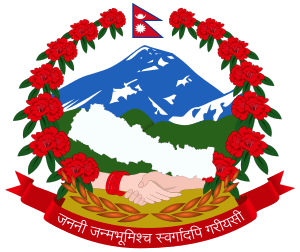President of Nepal
| President of the Federal Democratic Republic of Nepal
सङ्घीय लोकतान्त्रिक गणतन्त्र नेपालको राष्ट्रपति | |
|---|---|
 | |
| Style | The Right Honourable |
| Residence | Rastrapati Bhawan |
| Appointer | Indirect election |
| Term length |
Five years renewable once, consecutively |
| Inaugural holder | Ram Baran Yadav |
| Formation | 28 May 2008 |
| Deputy | Vice President of Nepal |
| Salary | NPR 1,09,410 (monthly)[1] |
| Website | www.presidentofnepal.gov.np |
 |
|---|
| This article is part of a series on the politics and government of Nepal |
|
Executive:
Judiciary:
|
|
|
|
Related topics |
The President of the Federal Democratic Republic of Nepal (Nepali: नेपालको राष्ट्रपति, Nēpālakō rāṣṭrapati) is the head of state of Nepal and commander in chief of the Nepalese Armed Forces. The office was created in May 2008 after the country was declared as a republic. The first President of Nepal was Ram Baran Yadav. The current president is Bidhya Devi Bhandari, elected in October 2015. She is the first female head of state. The President is to be formally addressed as "The Right Honourable (Nepali: सम्माननीय, Sam'mānanīya)".
Origin
Under the Interim Constitution adopted in January 2007, all powers of governance were removed from the King of Nepal, and the Nepalese Constituent Assembly elected in the 2008 Constituent Assembly election was to decide in its first meeting whether to continue the monarchy or to declare a republic. During the suspension of the monarchy, Girija Prasad Koirala, then Prime Minister of Nepal, acted as Head of State. On 28 May 2008, the Assembly voted to abolish the monarchy. Dr. Ram Baran Yadav won the historic election from the Constituent Assembly, and was sworn in as the nation's first president ending a 247 year old monarchy.
Election and powers
The President is elected by an electoral college comprising the Parliament of Nepal and the members of the provincial legislatures. A law shall detetmine the weight of each of their votes.
Whoever receives a majority of the delegates' votes is elected. If no one receives a majority in the first round, runoffs are held between the top two candidates until one receives a majority.
The presidential term is five years. A President may be elected any number of times, but not more than twice in succession.
The President's powers are almost entirely ceremonial. In some parliamentary republics, the president is vested with executive powers on paper, but is bound by convention to act on the advice of the prime minister and the government. In Nepal, however, the President is not even the nominal chief executive, as the Constitution explicitly vests executive power in the Council of Ministers and the Prime Minister.
List of Presidents of Nepal
Head of state (acting)
| Name (Birth–Death) |
Portrait | Party | Took office | Left office |
|---|---|---|---|---|
| Girija Prasad Koirala (1924–2010) |
.jpg) |
Nepali Congress | 15 January 2007 | 23 July 2008 |
- Presidents of Nepal
| № | Name (Birth–Death) |
Portrait | Party | Elected | Took office | Left office | Vice President | Votes |
|---|---|---|---|---|---|---|---|---|
| 1 | Ram Baran Yadav (1948–) |
 |
Nepali Congress | Nepali presidential election of 2008 | 23 July 2008 | 29 October 2015 | Parmanand Jha | 308 / 601 (2nd round) |
| 2 | Bidhya Devi Bhandari (1961–) |
Communist Party of Nepal (Unified Marxist–Leninist) | 2015 presidential election | 29 October 2015 | Incumbent | Nanda Kishor Pun | 327 / 601 | |
| 2018 presidential election | 39,275 / 52,569 | |||||||
See also
- King of Nepal
- List of heads of state of Nepal, for a comprehensive list of Nepalese heads of state since 1768
- List of Prime Ministers of Nepal
- Vice President of Nepal
References
- ↑ "Salary of President". Naya Patrika. 17 July 2013. Retrieved 17 July 2013.